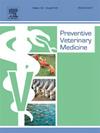Harmonisation of the diagnostic performances of serological ELISA tests for C. burnetii in ruminants in the absence of a gold standard: Optimal cut-offs and performances reassessment
IF 2.2
2区 农林科学
Q1 VETERINARY SCIENCES
引用次数: 0
Abstract
None of the three ELISA tests currently available in Europe for the serological diagnosis of Coxiella burnetii (C. burnetii) infections in ruminants can be considered as a gold standard. The difference in their diagnostic performances (e.g., from 39 % to 87 % for sensitivity in sheep – Lurier et al. 2021) affects the agreement between the test results obtained in different veterinary laboratories and limits the comparability of prevalence estimates for surveillance. In order to harmonise these tests, we tried to adjust their cut-offs so that there is a maximum of agreement between them. Using the results of the three ELISAs applied to 1258 cattle, 1474 goat and 1432 sheep serum samples collected in France, we identified the cut-offs that maximised Hubert’s kappa, an agreement coefficient applicable to more than two tests, using a differential evolution algorithm for optimisation. We then evaluated the effect of changing the cut-offs. In particular, we estimated the sensitivities and specificities of each test at the optimal cut-offs using a latent class model. While the manufacturer’s cut-offs of the three tests were 30, 40 and 40 respectively, regardless of the species, the cut-offs that maximise the agreement are 44.7, 30.8 and 84.3 for cattle, 6.6, 18.8 and 49.8 for goats, and 26.2, 50.9 and 88.6 for sheep. By using these cut-offs instead of those provided by the manufacturers, the observed proportion of disagreement between the tests is reduced by approximately half, and the diagnostic performances and apparent prevalence are more consistent from one test to another. The use of these species-specific cut-offs allows for better harmonisation of the tests. However, before implementing these new cut-offs, it is essential to assess the measurement uncertainty around them to ensure that the analytical performances of the tests are maintained.
在没有金标准的情况下,统一反刍动物伯氏菌血清学ELISA检测的诊断性能:最佳截止值和性能重新评估
欧洲目前可用于反刍动物伯纳蒂克希菌感染血清学诊断的三种ELISA检测方法中,没有一种可被视为金标准。它们诊断性能的差异(例如,绵羊的敏感性从39% %到87% %——Lurier et al. 2021)影响了不同兽医实验室获得的检测结果之间的一致性,并限制了监测流行率估计的可比性。为了协调这些测试,我们试图调整它们的截止值,以便它们之间有最大的一致性。利用在法国收集的1258头牛、1474头山羊和1432头绵羊血清样本中应用的三种elisa的结果,我们确定了使用差分进化算法进行优化,使休伯特kappa(适用于两个以上测试的一致系数)最大化的截止点。然后我们评估了改变截止值的效果。特别是,我们使用潜在类别模型估计了每个测试在最佳截止点的敏感性和特异性。尽管制造商对三个测试的截止值分别为30,40和40,但无论物种如何,最大协议的截止值分别为牛的44.7,30.8和84.3,山羊的6.6,18.8和49.8,绵羊的26.2,50.9和88.6。通过使用这些截止值而不是制造商提供的截止值,检测之间观察到的不一致比例减少了大约一半,并且从一个测试到另一个测试的诊断性能和表观患病率更加一致。使用这些特定物种的截止值可以更好地协调测试。然而,在实施这些新的截止点之前,评估它们周围的测量不确定度是必要的,以确保维持测试的分析性能。
本文章由计算机程序翻译,如有差异,请以英文原文为准。
求助全文
约1分钟内获得全文
求助全文
来源期刊

Preventive veterinary medicine
农林科学-兽医学
CiteScore
5.60
自引率
7.70%
发文量
184
审稿时长
3 months
期刊介绍:
Preventive Veterinary Medicine is one of the leading international resources for scientific reports on animal health programs and preventive veterinary medicine. The journal follows the guidelines for standardizing and strengthening the reporting of biomedical research which are available from the CONSORT, MOOSE, PRISMA, REFLECT, STARD, and STROBE statements. The journal focuses on:
Epidemiology of health events relevant to domestic and wild animals;
Economic impacts of epidemic and endemic animal and zoonotic diseases;
Latest methods and approaches in veterinary epidemiology;
Disease and infection control or eradication measures;
The "One Health" concept and the relationships between veterinary medicine, human health, animal-production systems, and the environment;
Development of new techniques in surveillance systems and diagnosis;
Evaluation and control of diseases in animal populations.
 求助内容:
求助内容: 应助结果提醒方式:
应助结果提醒方式:


